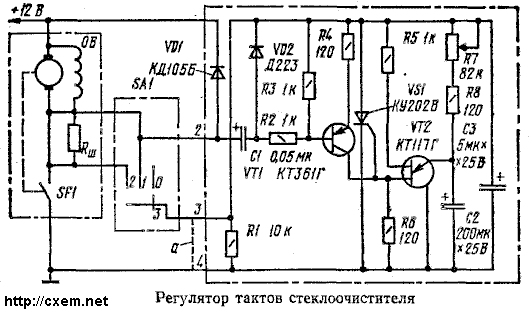
|
|
ENCYCLOPEDIA OF RADIO ELECTRONICS AND ELECTRICAL ENGINEERING Car wiper cycle control
Encyclopedia of radio electronics and electrical engineering / Automobile. Electronic devices Modern cars are equipped with a windshield wiper that can operate in a continuous and pulsating mode of brush movement. The second mode is very convenient in drizzling rain and light snow, but early production cars and some modern models, such as Moskvich-2140, do not have a pulsating mode, which creates certain inconveniences during their operation. The proposed device allows you to get an adjustable pulsating mode of operation of the wiper. Unlike previously published devices that use additional switches and electromagnetic relays, this regulator is designed to use a regular wiper operating mode switch and is non-contact. Connecting the circuit to the switch does not change the existing modes of operation of the brushes (fast, slow), but only sets a pause between the cycles of these modes. The pause is set by a variable resistor, the handle of which is displayed on the front instrument panel. The device, the scheme of which is shown in fig. 1, consists of a thyristor key VS1, a pulse generator based on a unijunction transistor VT2 with elements C2, R5-R8, an initial thyristor turn-on unit - VT1, C1, VD2, R1-R4, self-induction EMF protection elements - diode VD1 and capacitor C3.  The device works as follows. In the initial state, switch SA1 is off, the device is de-energized, contact SF1 is open, capacitor C1 is charged to the voltage of the on-board network, charging circuit C1 is as follows: +12 V, excitation winding (OB), C1, VD2, R1, common bus. When the switch SA1 is turned on, its contacts 1, 3 are closed, applying the supply voltage and simultaneously connecting the charged capacitor C1 to the base-emitter junction of the transistor VT1, which opens during the discharge of this capacitor and turns on the thyristor VS1. The wiper motor turns on, closes its SF1 contact, mechanically connected to it, and simultaneously shunts the power supply circuit of the generator and the thyristor, the latter closes, and the engine remains on using the SF1 contact. After a double stroke of the brushes, contact SF1 opens and the motor is switched off. From this point on, the device again receives power through the motor winding and field winding. Capacitor C2 of the generator starts charging through resistors R7 and R8, and capacitor C1 and its charging circuit with diode VD2 are shunted by contacts 1, 3 of the switch, transistor VT1 is closed. When the threshold voltage on the capacitor C2 is reached, the transistor VT2 opens, opens the thyristor, and the cycle repeats. The charging time of the capacitor C2 is mainly determined by the resistance of the variable resistor R7. When the resistance of the resistor R7 is minimal, then the charging time is short - the wiper works continuously. At the maximum resistance of the resistor, the charging time of the capacitor C2 is maximum - the wiper cycles in 15 s. By changing the resistance of the resistor R7, the desired operating mode of the wiper is set in the range of 0 ... 15 s. After the switch SA1 is turned off, contacts 1, 3 open and the capacitor C1 is charged to the voltage of the on-board network, when the switch is turned on again, the transistor VT1 will turn on the thyristor again. Thus, the first stroke of the brushes will always occur immediately after the switch is turned on, the second and subsequent ones will be repeated depending on the position of the variable resistor R7 engine at the moment. The introduction of the transistor VT1 into the circuit with the elements listed above made it possible to turn on the thyristor once, regardless of the position of the variable resistor R7 slider, each time the mode switch is turned on. When the switch SA1 is turned on in the second position (contacts 2, 3 are closed) - the mode of fast movement of the brushes - all the processes of turning on the engine, forming a pause and turning it off are similar to those described. The circuit connection is four-wire. Terminals 3, 4 of the device are connected to a break in the common wire (a) of the switch (see diagram), terminal 2 - output of capacitor C1 - to contact 1 of the switch - low speed of the electric motor, terminal 1 - to the +12 V power bus. All elements are placed on a printed circuit board, placed in a plastic case and fixed to a variable resistor R7, which is also an element of fastening the device on the dashboard. The device uses MLT resistors, a variable resistor SP-1, capacitors: C2, SZ-K50-6, C1-MBM; diodes - VD1 - D223, VD2 - KD105B. Installing a thyristor on a radiator is not required. The device is not critical to the replacement of semiconductor elements. Author: A. Kuzema, VRL, issue 93; Publication: cxem.net
See other articles Section Automobile. Electronic devices
Artificial leather for touch emulation
15.04.2024 Petgugu Global cat litter
15.04.2024 The attractiveness of caring men
14.04.2024
▪ electronics news magazines (annual archives) ▪ book Radio - it's very simple! Iceberg E., 1963 ▪ article Why do we eat? Detailed answer ▪ article Improved musical metronome. Encyclopedia of radio electronics and electrical engineering ▪ reference book Service menus of foreign TVs. Book #20
Home page | Library | Articles | Website map | Site Reviews www.diagram.com.ua |






 Arabic
Arabic Bengali
Bengali Chinese
Chinese English
English French
French German
German Hebrew
Hebrew Hindi
Hindi Italian
Italian Japanese
Japanese Korean
Korean Malay
Malay Polish
Polish Portuguese
Portuguese Spanish
Spanish Turkish
Turkish Ukrainian
Ukrainian Vietnamese
Vietnamese
 Leave your comment on this article:
Leave your comment on this article: